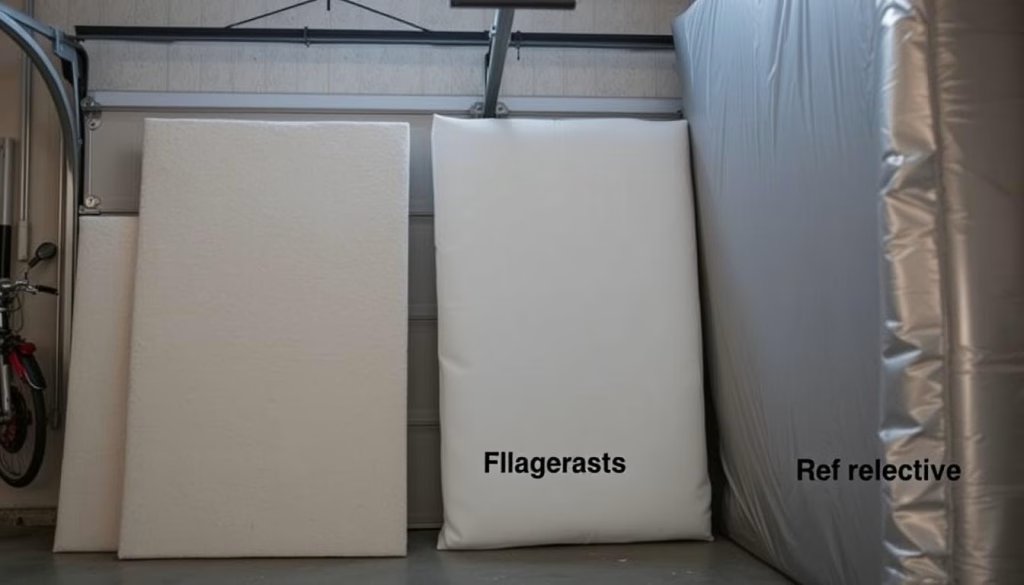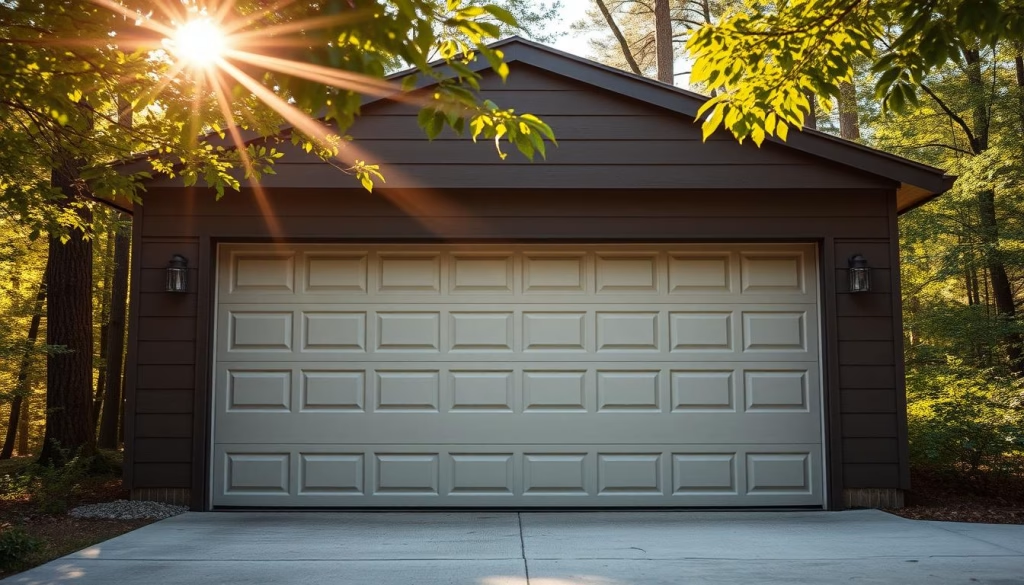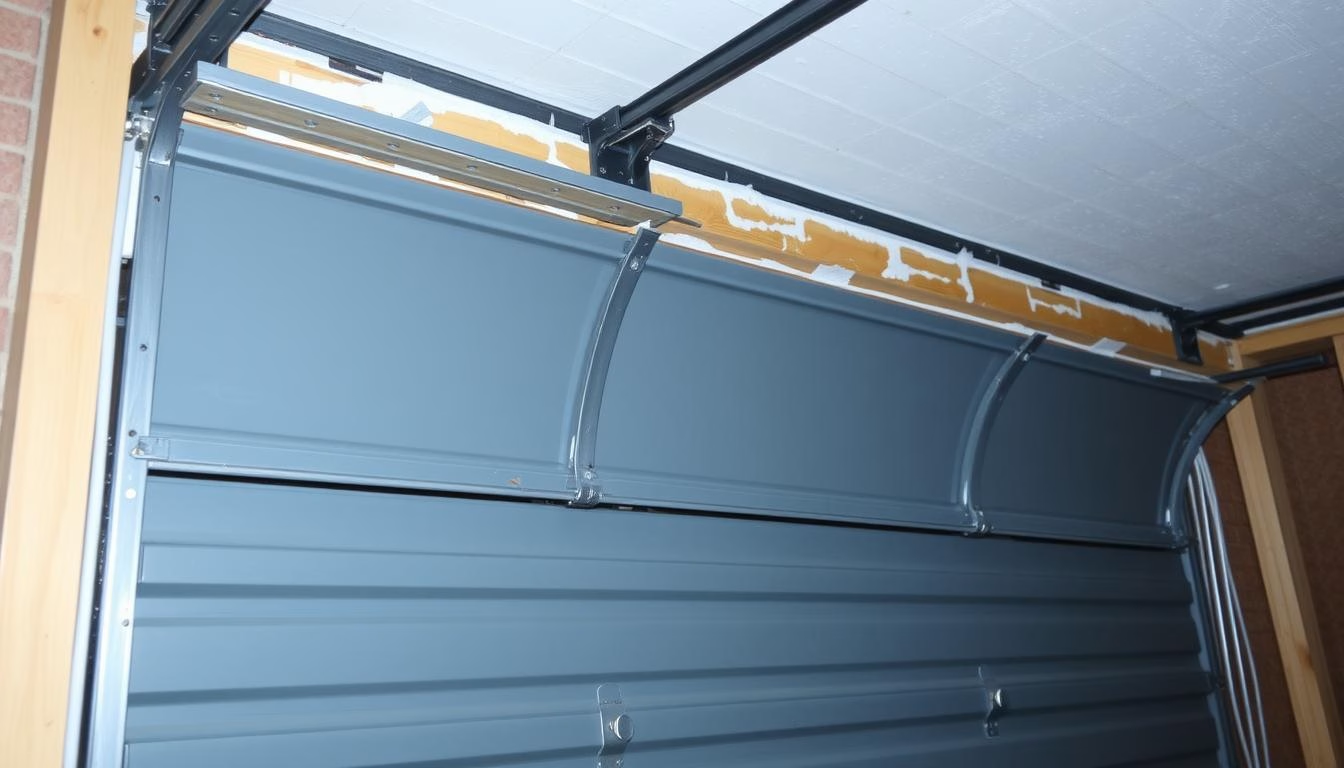Insulating a non-insulated garage door can significantly enhance its comfort and functionality. It may not drastically improve thermal insulation but offers notable benefits. These include noise reduction and increased energy efficiency. Choosing the right materials and techniques can make insulating your garage door a cost-effective solution.
Industry experts recommend using mineral wool blankets and polystyrene panels. These materials add insulation without significantly increasing the door’s weight. This is important to avoid unbalancing and potential damage to the door.
Key Takeaways
- Insulating an uninsulated garage door offers improved noise reduction and energy efficiency.
- Mineral wool blankets and polystyrene panels are the recommended materials for this purpose.
- Excessive weight on the garage door should be avoided to prevent damage.
- Proper installation techniques are crucial for effective insulation.
- Consult with experts if unsure about doing it yourself.
Understanding Garage Door Insulation
Garage door insulation is key to enhancing your garage’s efficiency and comfort. By examining different insulation options, homeowners can significantly boost their garage’s thermal performance. This improvement leads to reduced noise and notable energy savings.
What is Garage Door Insulation?
Garage door insulation involves adding materials to improve its acoustic and thermal properties. Common materials include mineral wool blankets and polystyrene panels. The goal is to create a barrier that reduces heat loss in winter and heat gain in summer. This maintains a stable temperature inside the garage.
Benefits of Insulating Your Garage Door
Insulating your garage door offers numerous advantages. An insulated door can significantly reduce noise, making your environment quieter. It also enhances energy efficiency by maintaining a consistent temperature, reducing the need for heating or cooling.
Furthermore, insulation can make your garage door more durable. It adds strength, protecting against impacts and harsh weather conditions.
Common Types of Insulation Materials
Knowing the different insulation materials available is crucial for selecting the right option. Here are three common types used in DIY garage door insulation:
| Material | Description | Advantages |
|---|---|---|
| Polystyrene Panels | Rigid foam boards inserted into the door panels | High insulative value, lightweight, easy to cut and install |
| Polyurethane Foam | Spray foam that expands to fill gaps | Excellent R-value, provides rigidity and strength |
| Reflective Insulation | Foil-faced materials that reflect radiant heat | Reduces heat transfer, economical, easy installation |
Exploring these insulation options helps you choose the best material for your budget and DIY skills. Whether you prefer the flexibility of insulated panels or the superior insulation of spray foam, understanding these choices is essential. It guides you in making the best decision for your garage door insulation project.
Signs Your Garage Door Needs Insulation
Identifying when your garage door needs insulation can prevent discomfort and save money. Several signs indicate the necessity of insulating a metal garage door.
Temperature Fluctuations
Noticeable temperature changes in your garage suggest it’s time for insulation. An uninsulated door lets heat out in winter and in during summer. This makes your garage uncomfortable all year.
Noise from Outside
External noise easily heard inside your garage is another sign. Insulating your metal garage door can block outside sounds. This creates a quieter space within.
Increased Energy Bills
Higher energy bills might mean your garage door isn’t insulated. Without insulation, your garage can increase heating and cooling costs. Your HVAC system works harder, leading to higher bills. Insulating your garage door can cut these costs down.
Preparing to Insulate Your Garage Door
Before starting the project of adding insulation to your garage door, it’s crucial to prepare properly. This involves gathering the necessary tools, understanding safety measures, and accurately measuring your garage door.
Tools and Materials Required
To begin, you’ll need specific tools and materials for a smooth installation. Key items include:
- Measuring tape
- Insulation panels or rolls
- Utility knife
- Adhesive or insulation fasteners
- Safety gear (gloves, safety glasses, and dust mask)
Having these tools ready will make the process of adding insulation to your garage door more efficient and effective.
Safety Precautions
Safety is paramount when adding insulation to a garage door. Wear gloves to protect your hands from sharp edges and insulation material. Safety glasses will prevent debris from entering your eyes, and a dust mask prevents inhaling small insulation particles. Also, ensure your garage is well-ventilated to avoid fume buildup from adhesives or insulation materials.
Measuring Your Garage Door
Accurate measurements of your garage door are essential. Use a measuring tape to record the dimensions of each panel. This will help you determine the amount of insulation material needed. Precise measurements ensure the insulation fits perfectly, maximizing its benefits.
Proper preparation not only ensures a successful installation but also enhances insulation efficiency. This leads to a more comfortable garage environment.
DIY vs. Professional Insulation
Choosing the right insulation for garage doors often comes down to DIY or professional installation. Each method has its own set of advantages and challenges, depending on your skills and needs.
Advantages of DIY Insulation
DIY insulation offers several benefits. It can save you money by avoiding labor costs. If you enjoy DIY projects, insulating your garage door can be a fun and fulfilling task. Plus, you can customize the insulation and see its effectiveness right away.
When to Hire a Professional
However, there are times when professional help is better. For complex garage setups or where top-notch insulation is crucial, experts can provide a more thorough and precise job. They know how to handle different materials and adjust the door for insulation, keeping it in good condition. This is especially true for detached garage doors in harsh climates.
Cost Considerations
The choice between DIY and professional insulation often depends on your budget and goals. DIY insulation costs only the materials, like foam boards and tools. Professional services, however, include labor and guarantee quality and efficiency. When deciding, weigh the initial cost against long-term savings and durability. Professional installation might offer more energy savings and durability, making it worth the extra expense.
How to Insulate a Garage Door: Step-by-Step
Starting an energy-efficient garage requires insulating your garage door correctly. This step ensures consistent temperatures and lowers energy costs. Here are the steps to insulate your garage door using various methods.
Insulating with Foam Board
Foam board insulation is favored for its simplicity and effectiveness. First, measure your garage door’s panels. Cut the foam board to fit perfectly, ensuring a tight seal. Use adhesive or clips to secure it. This method boosts thermal resistance, making your garage door more energy-efficient.
Using Reflective Insulation
Reflective insulation deflects radiant heat, keeping your garage cooler. Cut the material to match your door’s panels. Use adhesive or double-sided tape to hold it in place. It’s especially useful in sunny areas, improving your garage door’s thermal efficiency.
Sealing Gaps and Cracks
Sealing gaps and cracks is crucial for maximum efficiency. Use weather stripping or caulk to seal openings around the door. This step greatly reduces air leaks, enhancing your garage door’s performance.
By following these steps, you can achieve a well-insulated, energy-efficient garage door. This will improve both comfort and save on costs.
Garage Door Insulation Kits
Insulation kits are a top pick for garage door insulation. They come with everything needed to insulate your garage door. This ensures better energy efficiency and temperature control.

What’s Included in a Kit?
Insulation kits include pre-cut panels for standard garage door sizes. They also have fastening materials like retainer clips and adhesive. Some kits even include weatherstripping for better insulation and performance.
Popular Brands of Insulation Kits
Many brands offer insulation kits for various needs and budgets. Owens Corning, Matador, and Reach Barrier are well-known for their quality. Owens Corning kits, for example, use fiberglass insulation with vinyl faces. This combination boosts durability and insulation efficiency.
Installation Instructions
Each kit comes with clear installation instructions. Homeowners can easily follow these steps. The process involves cleaning the door, cutting insulation if needed, and securing it with adhesive and clips. Proper installation maximizes energy savings and comfort.
Insulation Techniques for Different Garage Door Types
Different garage doors need specific insulation methods for maximum efficiency and comfort. Knowing these techniques helps in picking the right insulation for your garage door type.
Insulating Steel Garage Doors
Reflective insulation is highly effective for metal garage doors. It reflects heat away from the surface. A reflective barrier, like foil, is placed inside the door to reduce heat transfer. It’s crucial to ensure the material is tightly adhered to avoid gaps that could reduce its effectiveness.
Wooden Garage Door Insulation
Wooden garage doors often use foam boards or mineral wool for insulation. These materials have excellent thermal resistance. Foam boards can be cut to fit panel sizes and adhered with a strong adhesive. Mineral wool offers superior acoustic and thermal properties, making it a top choice for maintaining a stable garage temperature.
Insulating Multi-Panel Doors
Insulating multi-panel garage doors is more challenging due to their segmented nature. Each panel must be insulated individually for overall effectiveness. Reflective insulation, foam boards, or spray foam can be used between panels. Sealing all gaps is crucial to prevent air leaks, which can undermine insulation efforts.
| Garage Door Type | Recommended Insulation Material | Benefits |
|---|---|---|
| Steel | Reflective Insulation | Reduces heat transfer, cost-effective |
| Wooden | Foam Boards, Mineral Wool | Excellent thermal resistance, soundproofing |
| Multi-Panel | Reflective Insulation, Foam Boards, Spray Foam | Ensures complete insulation coverage |
Maintaining Your Insulated Garage Door
Keeping your insulated garage door in top shape requires consistent care. Regular inspections and proper maintenance can greatly extend its lifespan and efficiency. Here are essential steps to maintain your insulated garage door.
Regular Inspections
It’s vital to conduct regular checks for any signs of insulation material dislodgment or degradation. This ensures your insulated garage door remains effective. Look for gaps or areas where insulation might have shifted or become loose.
Cleaning and Care
Proper cleaning is key to maintaining your insulated garage door. Use a soft cloth and a gentle cleaner to clean the surface without harming the insulation. For optimal results, steer clear of harsh chemicals or abrasive tools that could damage the insulation.
Detecting and Repairing Damage
Identifying and fixing damage early on is crucial. Regularly inspect the door for wear and tear, like cracks or holes in the insulation. Addressing these issues promptly helps prevent further damage and keeps your garage door well-insulated.
The Environmental Impact of Garage Door Insulation
Choosing the best insulation for your garage door enhances your home’s comfort and has major environmental benefits. It boosts energy efficiency, cuts down on carbon emissions, and saves money in the long run.
Energy Efficiency Benefits
Insulating your garage door significantly improves energy efficiency. It keeps your garage at a consistent temperature, reducing the need for extra heating in winter and cooling in summer. This results in lower energy use overall.

Reducing Carbon Footprint
Insulation helps lower your home’s carbon footprint by reducing energy needs. Less energy use means fewer greenhouse gases, helping fight climate change.
Cost Savings Over Time
Investing in top-notch garage door insulation saves money in the long term. Lower energy bills are a direct result of reduced consumption. Although the upfront cost is high, the long-term financial and environmental gains are well worth it.
Temperature Control in the Garage
Maintaining optimal temperature in your garage is more than just adding insulation to the door. It ensures a comfortable workspace and protects your stored items.
Heating Options for Garages
As winter arrives, heating your garage becomes crucial. You can choose from portable space heaters to more permanent solutions like forced-air and infrared heaters. Space heaters are handy for small garages but may not suffice for larger ones. Forced-air heaters are more expensive but efficiently warm up bigger spaces by circulating warm air.
Infrared heaters, on the other hand, provide targeted warmth by radiating heat directly to objects and people. Pairing insulation with the right heating method significantly enhances temperature stability.
Cooling Solutions for Garages
In summer, high temperatures can make your garage unbearable. Portable air conditioners, window units, and ductless mini-split systems are effective cooling options. Portable air conditioners are flexible but less powerful than window units, which are more energy-efficient for fixed setups.
Ductless mini-split systems offer the best climate control, providing both heating and cooling. Adding insulation to your garage door makes these cooling methods more effective, ensuring a comfortable environment.
Importance of Ventilation
Proper ventilation is key to managing garage temperature. It helps remove excess moisture, preventing mold and mildew. You can choose from passive or active ventilation systems, including vents, exhaust fans, and dehumidifiers.
Passive vents rely on natural airflow, while exhaust fans actively circulate air. Dehumidifiers help control humidity levels, making your garage healthier. Combining these methods with insulation ensures a balanced garage climate.
Frequently Asked Questions
Many individuals seek answers on the cost, practicality, and details of garage door insulation. We aim to address common queries to assist you in your DIY garage door insulation endeavor.
How Much Does Garage Door Insulation Cost?
The expense of garage door insulation varies widely. It depends on the materials chosen and the garage door’s size. Typically, costs range from $100 to $500 for most DIY projects. Premium materials will elevate the price but enhance insulation quality and longevity.
Can I Insulate My Garage Door Myself?
Indeed, many homeowners successfully undertake DIY garage door insulation. Basic DIY proficiency and standard tools are usually enough. Yet, for complex tasks or large, intricate doors, professional assistance might be advisable for the best outcome.
What R-Value Should I Aim For?
The R-value indicates insulation effectiveness. The desired R-value for your garage door hinges on your climate and needs. Typically, an R-value between R-8 and R-16 is ideal for most homes, balancing thermal resistance and energy efficiency. Regions with harsher climates might need higher R-values.
Conclusion: Is It Worth Insulating Your Garage Door?
Considering the question, can you insulate an uninsulated garage door?, it’s evident that this upgrade offers several advantages. Insulating your garage door can lead to noise reduction, better temperature control, and possibly lower energy bills. This transformation makes your garage more versatile and comfortable, without the need for a full garage renovation.
Recap of Benefits
The main advantages of insulating your garage door include enhanced energy efficiency, reduced outside noise, and improved comfort. An insulated garage also safeguards your belongings from extreme temperatures. When weighing costs against benefits, insulating your garage door proves to be a worthwhile investment.
Final Thoughts on Insulation Decisions
Insulating an uninsulated garage door comes with initial costs and labor. However, the long-term advantages justify the investment. Whether you opt for a DIY project or professional help, the outcome is a more energy-efficient and quieter garage. Thus, if you’re wondering, can you insulate an uninsulated garage door, the answer is a resounding yes. Insulation brings comfort, savings, and a superior living environment.













